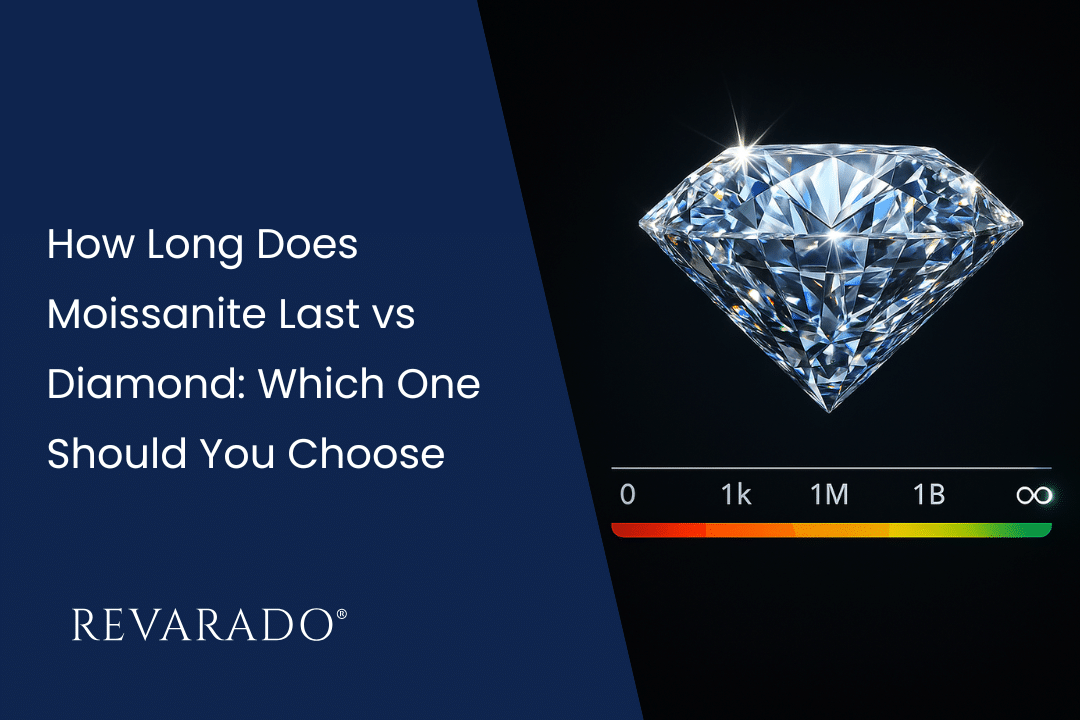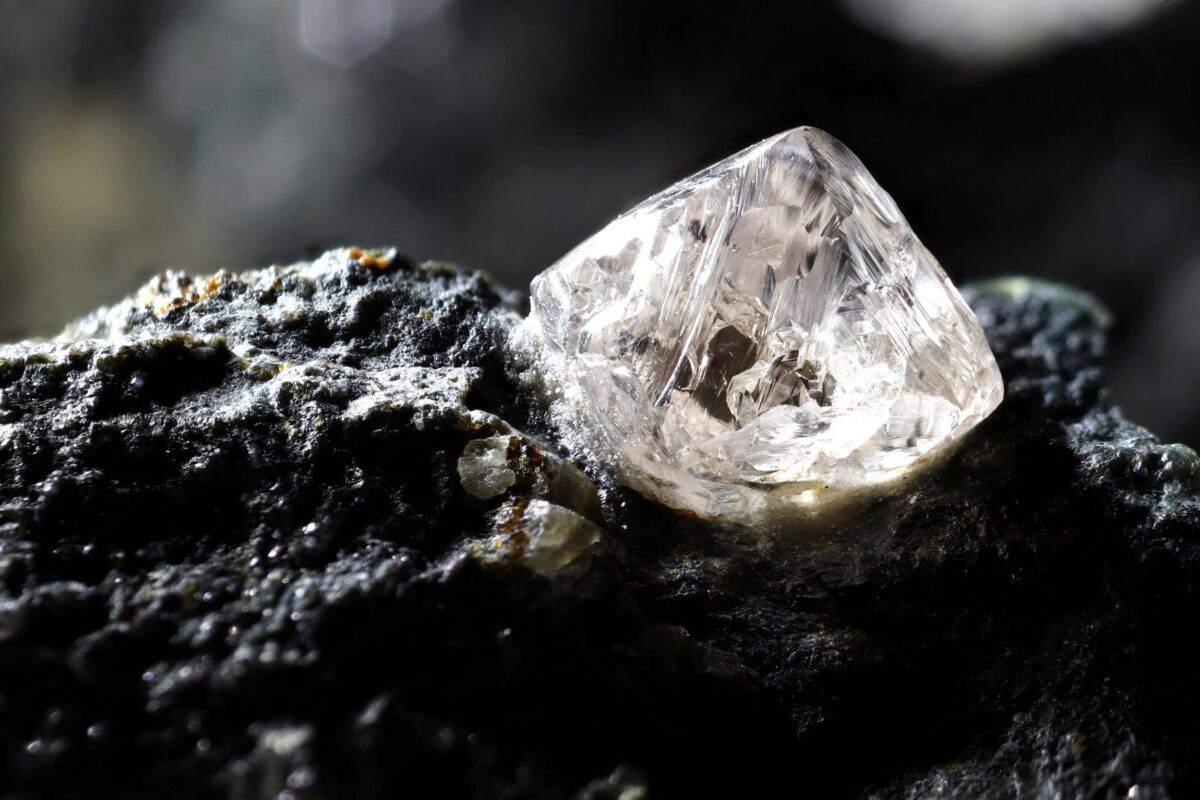How Long Does Moissanite Last vs Diamond: Which One Should You Choose

How long does Moissanite last vs diamond – if you’re shopping for an engagement ring or sparkly jewelry, you’ve likely heard this debate. Revarado’s moissanite gemstones have emerged as a compelling alternative to diamonds, boasting several advantages in brilliance, price, and ethics. But should you buy moissanite, and how does it truly stack up against a diamond (including lab-grown diamonds)? In this comprehensive comparison, we’ll explore the advantages and differences of moissanite jewelry across various optical properties, durability, price, and more. By the end, you’ll have a clear sense of whether moissanite or diamond is the right choice for your needs.
Long-Term Wear and How Long Does Moissanite Lasts
One common question is whether moissanite will get cloudy or lose its sparkle over time. The answer is no, moissanite does not get cloudy with age. Any cloudiness would likely be due to surface grime, which can be easily cleaned off. Similarly, diamonds remain clear; they may look dull if dirty, but a quick cleaning restores their sparkle.
Speaking of cleaning, the maintenance for both is the same: regular, gentle cleaning to remove oils and dirt. Both stones attract oils (diamonds notoriously so – they have an affinity for grease), which can make them appear less brilliant until they are cleaned. The best routine is to soak the ring in warm, soapy water and gently brush it (an old soft toothbrush works great) once every week or two. Both moissanite and diamond can also be safely cleaned in ultrasonic cleaners or with steam cleaners that many jewelers use, due to their toughness.
If we consider very long-term horizons, diamonds have been worn in jewelry for centuries, and antique diamonds still retain their brilliance. Moissanite is a newer gemstone in the market (commercially available since the late 1990s). Still, given its physical properties, there’s every expectation that a moissanite will look just as good in 100 years as it does today. Moissanite’s longevity positions it as a “heirloom-quality” stone – it can be passed down to the next generation without worry.
In terms of everyday care and long-term maintenance, choosing moissanite over diamond doesn’t impose different burdens. Both are highly durable, require only basic cleaning, and will keep their sparkle over a lifetime.
Long-Term Value and Does Moissanite Last as Long as a Diamond
Buying a gemstone isn’t just an upfront cost – some buyers consider long-term value or the ability to resell the stone. Here’s how the three options compare:
- Natural Diamonds: Traditionally, diamonds have some resale value, but it’s often significantly below retail. The resale value of a diamond depends on the market and quality; however, a general rule is that you might recoup 25% to 50% of what you paid if you sell a diamond ring (unless it’s a very special or investment-grade stone). Diamonds are not truly an “investment” for consumers in most cases; however, they are a store of value to the extent that a used diamond still has monetary worth. In short, expect natural diamonds to have moderate resale value – not zero, but not profit-generating either.
- Lab-Grown Diamonds: Right now, lab-grown diamonds depreciate more quickly. Since they can be produced in unlimited quantities (and the cost of production has been decreasing), the market price for new lab diamonds continues to decline. A lab diamond bought a couple of years ago might be selling new for much less today, which means a used one is even cheaper. Some estimates as of 2024 showed lab diamonds retailing at around 10-20% of the price of an equivalent natural diamond, and as production increases, that percentage could drop further. Don’t expect to get anywhere close to what you paid; the resale value is generally low (and some jewelers or buyers might not purchase lab stones at all, since they can get new ones easily).
- Moissanite: Moissanite’s resale value is also relatively low. Since moissanites are inexpensive to begin with and not scarce, the secondhand market is limited. If you tried to pawn a moissanite ring, you’d get a fraction of what a similar diamond ring would fetch. Some pawn shops do accept moissanite jewelry, but the resale value will likely be lower than that of a diamond. Essentially, you should buy a moissanite for its beauty and affordability, not with any expectation of reselling it for a significant amount of money. Think of moissanite as a consumption good in jewelry – its value is in wearing and enjoying it, not in resale. The flip side is that because you spend much less upfront, you’re not tying up a lot of money in the stone anyway. Many people are comfortable with this trade-off, reasoning that they’d rather save thousands now than worry about getting some money back later.

Consumer Perceptions and Practical Differences
Beyond the technical specs, what is it like to live with and wear a moissanite vs a diamond? Here we’ll discuss how they are perceived by wearers and observers, how they perform in different jewelry contexts, and any differences in long-term experience.
Can the Average Person Tell the Difference?
One common question is whether people can see that a stone is moissanite instead of diamond. The honest answer: most people, even many jewelers, can’t tell just by looking with the naked eye. Moissanites are designed to mimic the look of diamonds, and they do that job very well. Even trained gemologists typically need special tools to distinguish a moissanite. A classic test involves using a loupe (10× magnifying glass) to examine the double refraction in moissanite, or utilizing a moissanite tester that checks electrical conductivity. Without those, an untrained observer will almost certainly assume a colorless moissanite is a diamond.
However, there are a couple of visual giveaways in some cases. As mentioned earlier, large moissanites have that tell-tale fiery disco-ball sparkle with lots of rainbow flashes. If someone is familiar with diamonds, they might find the moissanite’s excess fire to look a bit different, possibly “too much sparkle” or more colorful than expected. Some people say under department store spotlights or sunlight, a big moissanite’s bling is a bit more conspicuous or even “unnaturally” sparkly compared to a diamond. Another potential giveaway can be the slight body color; in certain lighting, a moissanite might show a hint of warmth that a top-grade diamond wouldn’t, as discussed before. But again, these differences are subtle.
Conclusion: Which Should You Choose?
When it comes to moissanite vs diamond, the choice ultimately hinges on your priorities and values. Both stones can create a stunning piece of jewelry, but they offer different pros and cons:
- Choose Moissanite if you want a stunning, brilliant gemstone that offers tremendous value. With moissanite, you can get a larger or more impressive-looking ring for a fraction of the cost of a diamond. You’ll also have the peace of mind that comes from its ethical, lab-grown origin and sustainable footprint. For many, the advantages of moissanite jewelry (affordability, sparkle, durability) far outweigh any drawbacks. It’s an ideal option if you love the look of a diamond but balk at the price, or if you’re philosophically opposed to spending big on a ring or contributing to mining. In terms of everyday wear, you won’t be sacrificing anything – moissanite is hard and resilient enough to last a lifetime, and most people will assume it’s a diamond anyway. And since the question of “how long do moissanite rings last” has already been covered, it’s clear that they’re also a perfect choice for newly engaged couples.
- Choose a Natural Diamond if you value the traditional prestige and rarity of a mined gem. There is an undeniable romantic appeal to a diamond. Some people simply feel a certain way about natural diamonds – they appreciate the natural origin, the fact that it’s one-of-a-kind from the ground. You might also choose natural if you’re after a specific natural fancy color or just want the “real thing” as defined by the classic standard. Be prepared to pay a premium for the mystique and market value of natural diamonds, and also be aware that most of the diamonds are not ethically sourced.
- Choose a Lab-Grown Diamond if you want composition of a diamond, but at a lower cost and with virtually no ethical downside. Lab diamonds are chemically identical to natural diamonds, so your ring will sparkle the same and pass any diamond tester. You’ll spend significantly less than a natural diamond (though still more than moissanite), which may allow you to get a larger stone or a higher quality for your budget. It’s a great option if you can’t quite embrace moissanite’s distinct optical character (perhaps you prefer diamond’s more subtle fire and crisp look). Yet, you also balk at the high prices or questionable practices of natural diamonds. Keep in mind that the resale value of lab diamonds is generally low.
In any case, ensure you buy from a reputable jeweler who can provide a quality stone (well-cut and as described). A beautifully cut moissanite will outshine a poorly cut diamond, and vice versa. So, quality matters, regardless of what you choose.
Hopefully, this comparison has given you clarity on the differences in brilliance, fire, durability, price, and ethics between moissanite and diamonds. Whether you go for that fiery moissanite gem or a sparkling diamond stone (natural or lab-grown), you can look forward to a ring that symbolizes your unique love story – and that truly lets your values shine. Enjoy your forever sparkle with Revarado!